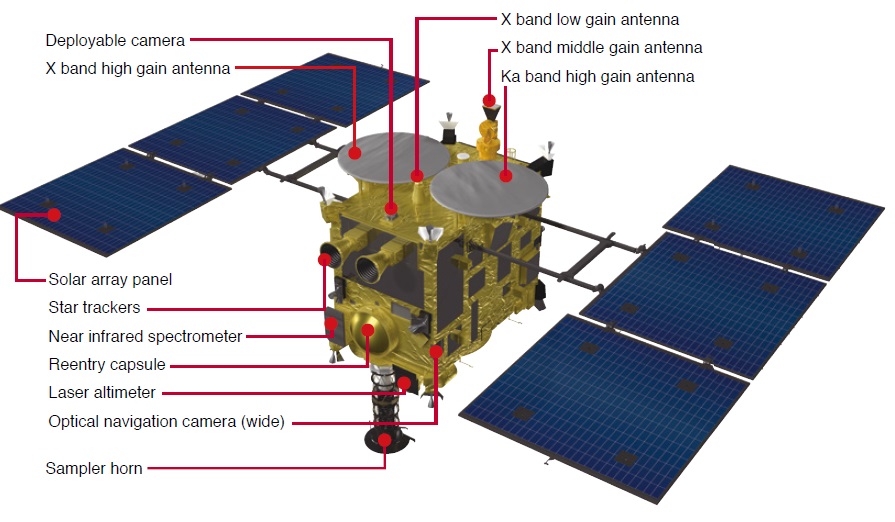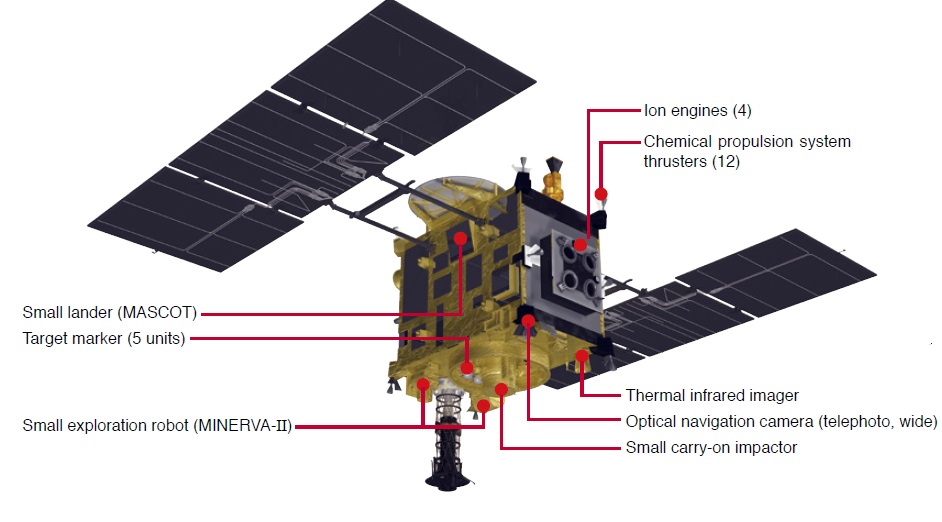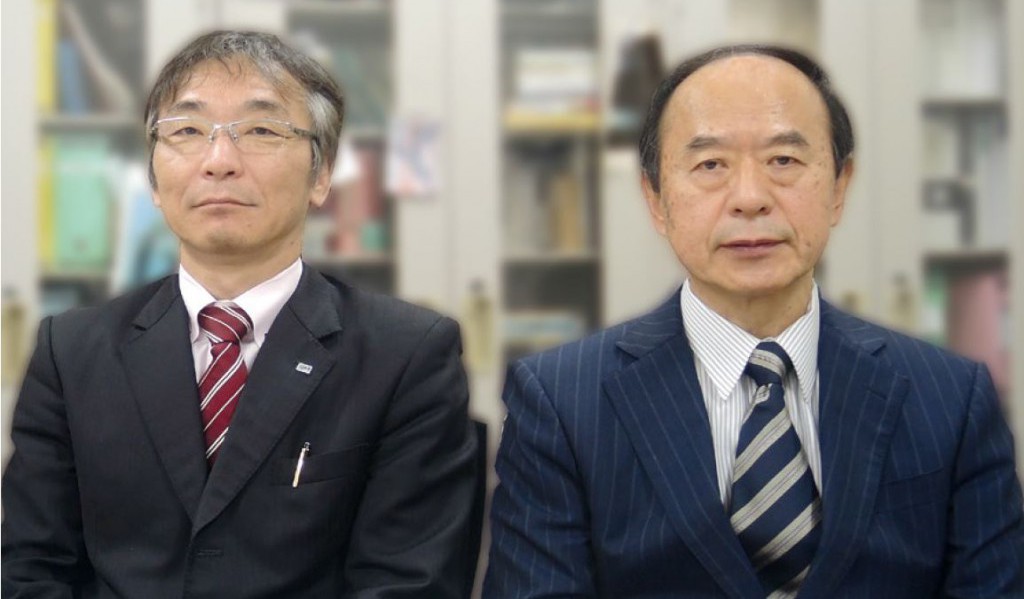This post is also available in: Japanese
Following the Success of the First Hayabusa, Hayabusa 2 Has Attracted a Great Deal of Attention
Obinata: This type of project probably has a large budget, but in order to ensure the success of a project that involves a large number of people, it is important to set a goal or mission that is ambitious enough to unite them, isn’t it?
Kuninaka: I think so. The target of the current project is extremely difficult to achieve and very challenging, but it’s certainly an interesting mission that inspires everyone and makes people want to take part in it. People in this field will already be aware of this, but it is important to get a place in the line for rocket launches. You cannot launch a satellite unless you have a place in the queue.
This is a matter of great concern to us. If a problem occurs during development, the order of launches is adjusted. For the Hayabusa project, other missions said that they would be willing to give up their place for us —such was the appeal of the mission. Everyone knew that Hayabusa was an attractive project, but it was probably only Dr. Junichiro Kawaguchi, the then project manager, who envisaged that the project would succeed. Since the first Hayabusa succeeded in returning to Earth in 2010 despite a number of twists and turns, the entire world has come to realize the objectives, significance, and value of asteroid explorations. The reason we succeeded in getting the Hayabusa 2 project underway in such a short period of time under these circumstances, despite facing a mountain of problems, was that the success of the first Hayabusa mission was shared among stakeholders in Japan and the rest of the world. This eliminated the need to explain the objectives and other details of the project, which spared us a great deal of trouble.
Obinata: The success of the Hayabusa mission was a particularly impressive achievement. But given the considerable reputation acquired by the first Hayabusa, wasn’t it all the more difficult to handle the Hayabusa 2 project because people had such great expectations for it?
Kuninaka: I’m exaggerating a little, but it is true that we did become the focus of public attention when we carried out the project (laugh). We felt as if our every move was being carefully watched by the public.
Obinata: Since this is a matter of concern to the general public as well, the entire nation is watching you closely. But when I visited some of your research and development facilities and offices a while ago, it was clear that the project members were not enjoying any luxuries (laugh).
Kuninaka: The Space Simulation Chamber was especially built to be used in the durability tests for the first Hayabusa’s ion engine. It was constructed within one or two years, but we had visited ion engine research institutes throughout the world during the preceding decade in order to observe chambers made specifically for conducting ion engine durability tests. We prepared so carefully that we were able to build JAXA’s Space Simulation Chamber quickly. In case you didn’t know, the cryopump we use to create an ultra-high vacuum is manufactured by ULVAC.
Obinata: Yes, I found that out at the laboratory a short while ago. Thank you very much for using our product (laugh).


| Hayabusa 2 | First Hayabusa | |
| Dimensions of the main body without solar panels | 1 m (width) × 1.6 m (length) × 1.25 m (height) | 1 m (width) × 1.6 m (length) × 1.1 m (height) |
| Mass | Approx. 600 kg (including fuel) | 510 kg (including fuel) |
| Date of launch | December 3, 2014 | May 9, 2003 |
| Carrier rocket | H-IIA rocket No.26 | M-V rocket No.5 |
| Communication frequency badn | X band (7 to 8 GHz) Ka band (32 GHz) |
X band (7 to 8 GHz) |
| Main exploration devices | Near infrared spectrometer, thermal infrared imager, optical navigation camera, laser altimeter, deployable camera, small carry-on impactor, sampler horn, MINERVAII, and MASCOT | Near infrared spectrometer, fluorescent X-ray spectrometer, multiband, spectroscopic camera, Laser altimeter, sampler horn, and MINERVA |
| Period of asteroid | Approx. 18 months | Approx. 3 months |
| Collection of stone and sand | Twice on the surface and once below the surface | Twice on the surface |
| Return to Earth | November to December 2020 (scheduled) | June 13, 2010 |
The Space Simulation Chamber Helped Facilitate Durability Tests for the Ion Engine
Saito: When someone mentions outer space, we tend to think of an ultra-low temperature, a dark expanse of space or an extremely harsh expanse of space with powerful solar radiation. How do you cope with the heat balance required to ensure that satellites work in the harsh environment of space?
Kuninaka: Heat management in space is extremely difficult. In a satellite, heat is transported via heat pipes, thermal conduction, and the like, but in the end, all of the heat is converted into infrared rays and released throughout a large area. The service life of semiconductors and other electronic components will be shortened if their temperature rises, and they will break if it rises too high. The higher the temperature becomes, the easier it is to discharge heat because, according to the Stefan-Boltzmann law, heat is released in proportion to the fourth power of the absolute temperature. Fortunately, the ion engine uses practically no electronic components, so there are few problems if it is operated at high temperature. However, the engine uses a magnet that is resistant to high temperatures so that it will not fail under such conditions.
Saito: At ULVAC, we use microwaves when we process something in a vacuum, but unlike with satellites, we do not operate machinery in a vacuum continuously for days or years. For your satellite, didn’t you have great difficulty in terms of ensuring durability?
Kuninaka: Well, we conducted thorough durability tests for the first Hayabusa. The chamber was actually installed for that purpose. We conducted two-year durability tests twice. We continued the trial operation of the chamber except when its operation was suspended for maintenance.
We spent about five years conducting durability tests, so we were able to observe the chamber’s true capabilities. Our project is special; we develop the ideas ourselves, produce the prototypes ourselves, deliver them to ourselves, and use them ourselves. Manufacturers like ULVAC design and manufacture products that are subsequently used not by themselves but by the customer, so your responsibility is greater. Since we completed 20,000 hours of durability tests, we believe that we have created something that is more or less acceptable. We have satisfied ourselves that sufficient durability tests have been conducted. If you don’t have confidence in your products, you cannot deliver them to your customers, can you?

